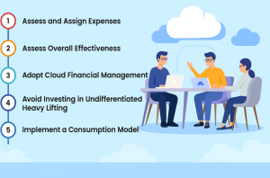From overspending to optimized, take control of your AWS costs today
Introduction
Cost optimization is a process of reducing expenses while maintaining or improving the quality of products or services, aiming to improve profitability and efficiency by identifying and eliminating unnecessary spending.
What is AWS Cost Optimization
AWS cost optimization is the practice of finding ways to reduce your AWS spending while maintaining or improving performance and reliability, through techniques like right-sizing resources, using reserved instances, and monitoring usage.

Techniques of Cost optimization
Key Principles of AWS Cost optimization

Principles of AWS Cost optimization
Adopt Cloud Financial Management:
To achieve financial success and accelerate business value realization in the cloud, you need to invest in Cloud Financial Management /Cost Optimization. Your organization needs to dedicate time and resources to build capability in this new domain of technology and usage management. Similar to your Security or Operational Excellence capability, you need to build capability through knowledge building, programs, resources, and processes to become a cost-efficient organization.
Implement a consumption model:
Pay only for the computing resources that you require and increase or decrease usage depending on business requirements, not by using elaborate forecasting. For example, development and test environments are typically only used for eight hours a day during the work week. You can stop these resources when they are not in use for a potential cost savings of 75% (40 hours versus 168 hours).
Assess Overall Effectiveness:
Measure the business output of the workload and the costs associated with delivering it. Use this measure to know the gains you make from increasing output and reducing costs.
Avoid spending in undifferentiated heavy lifting:
AWS does the heavy lifting of data center operations like racking, stacking, and powering servers. It also removes the operational burden of managing operating systems and applications with managed services. AWS cost management tools provide managed services to lessen the effort of running and maintaining operating systems and applications. These services relieve you of IT infrastructure tasks so you may concentrate on clients and commercial endeavors.
Assess and Assign Expenses:
The cloud makes it easier to accurately identify the usage and cost of systems, which then allows transparent attribution of IT costs to individual workload owners. This helps measure return on investment (ROI) and gives workload owners an opportunity to optimize their resources and reduce costs.
Benefits of AWS Cost Optimization

Benefits of AWS Cost Optimization
1) Cost Visibility and Analysis
Discuss how AWS Cost optimization tools provide insights into spending patterns, allowing businesses to identify areas of overspending or inefficiency through detailed cost breakdowns and analysis.
2) Resource Right-sizing
Highlight the benefits of AWS cloud optimization tools for right-sizing resources. These tools enable businesses to match instance types and sizes to their workload requirements, minimizing underutilization and over-provisioning costs.
3) Reserved Instance Optimization
Explain how AWS Cost optimization tools help manage Reserved Instances effectively, including recommendations for purchasing and modifying Reserved Instances to maximize cost savings while meeting performance needs.
4) Usage Monitoring and Alerts
Discuss the importance of AWS tools for monitoring usage and setting up alerts for cost anomalies or unexpected spikes in expenditure. These tools allow businesses to take proactive measures to control costs and avoid bill shocks.
5) Automation and Optimization Recommendations
Emphasize the value of AWS reporting tools in providing automated optimization recommendations, such as identifying idle resources, optimizing storage usage, or implementing cost-saving strategies like spot instances or scheduled scaling to improve cost efficiency without continuous manual intervention.
AWS Cost Optimization Best Practices
1) Identify Amazon EC2 Instances with Low Usage
The Resource Optimization report from Amazon Cost Explorer displays EC2 instances that are not being used or are being used inefficiently. Stopping or changing these instances to a reduced instance size will reduce costs. Amazon Operations Conductor’s automated instance scheduling and the AWS Instance Scheduler’s automatic instance termination are further options.
The Amazon Compute Optimizer provides further suggestions for EC2 instances. For instance, it could advise downsizing instances among instance families or switching to more powerful instances to avoid performance snags. It may also suggest how best to use Auto-Scaling groups.
2) Sell or Use Unused Reserved Instances
Reserved Instances on Amazon can drastically save prices, but only if you utilize them. Therefore, using unused reservations is crucial to protect your investment.
When a reserved instance becomes available, you can utilize it for a new application or an existing one currently using more expensive on-demand instances. However, should this not be the case, you can sell your RIs on the Reserved Instance Marketplace.
3) Use Amazon EC2 Spot Instances to Save AWS Costs
Spot Instances are a crucial component of the AWS cost-reduction plan and can save EC2 expenses by up to 90% if your workload is fault-tolerant. Spot instances may terminate with two minutes’ notice is the main restriction. Typical workloads include big data, containerized workloads, continuous integration/delivery (CI/CD), web servers, and development/testing.
Using Amazon’s Spot Fleet functionality, you may run spot and on-demand instances in the same Auto Scaling group while reserving some on-demand instances that cannot be interrupted for crucial components.
AWS Cost Optimization Tools

AWS Cost Optimization Tools
1) Cost Explorer
AWS Cost Explorer is a tool that aids in cost and consumption data visualization through an interactive and user-friendly interface. Data from AWS Cost Explorer is used to assess cost and usage across all AWS pricing model accounts, spot trends in cost consumption, and spot usage peaks.
Data from the last 12 months are presented to you via the tool, conveniently accessible through your choice analytics tool.
2) AWS Instance Scheduler
The Amazon instance scheduler utility assists you in automatically halting Amazon Relational Database Service (RDS) and Amazon EC2 instances using information from Cost Explorer. As a result, Amazon Web Services EC2 can be scaled and scheduled according to your anticipated usage pattern, demands, and requirements.
3) Amazon CloudWatch
CloudWatch assists you in setting alarms for particular resource levels by considering a range of metrics from your Amazon services. For instance, you could create an alarm to alert you if the percentage of your EC2 instances drops below 40%. Then, you can quickly assess instance underutilization after being alerted by the alarm, investigate it, and proportionally resize or combine the workloads.
4) AWS Budgets
You can establish the budget for particular Amazon services using AWS Budgets. Additionally, the budget can be linked to specific data that boosts efficacy. Finally, you can receive emails or messages from the Simple Notification Service (SNS) to notify you of AWS Budget occurrences.
Usage Example: You can set up an overall budget for the entire account or a specific resource, like using numerous Amazon EC2 instances or the Amazon CloudFront CDN etc.
5) Amazon Trusted Advisor
Amazon Trusted Advisor provides various functionalities, including enhancing security and performance, lowering overall costs, and optimizing your AWS infrastructure.
This examines your Amazon setup and offers best practice advice on service restrictions, performance, cost-cutting, security, and fault tolerance.
- Automatic Recommendations for Cost-Saving
- Optimizing EC2 reserved instances
- EC2 instances are only partially used
- Elastic load balancers that are idle
- Underused EBS volumes
- Elastic IP addresses without any connections
- Database instances on Amazon RDS that are not in use
6) Cost and Usage Report Tool
The Cost Usage and Report tool for Amazon Web Services (AWS) provides a detailed report of your AWS cloud cost optimization, consumption, service pricing, and other information on an hourly, daily, or monthly basis.
7) AWS CloudTrail
While on the go, you can manage, track, and log reports from your Amazon Web Service using CloudTrail. This tool informs you of any unusual spikes in activity that can raise costs and enable you to take appropriate action.

